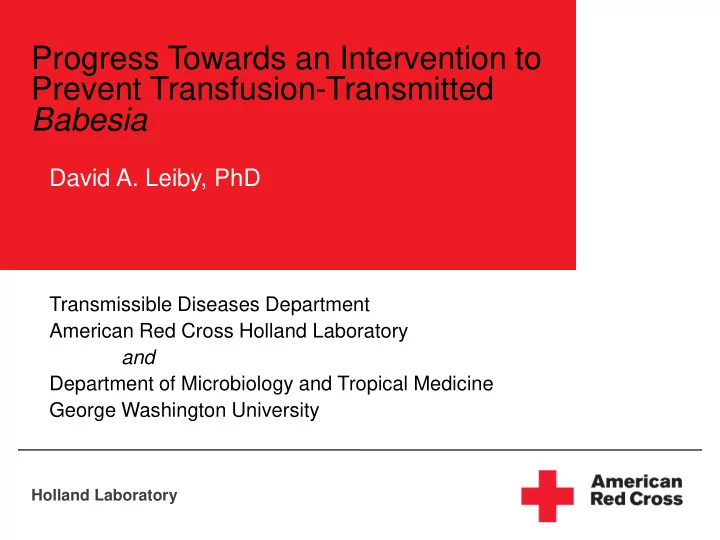

Progress Towards an Intervention to Prevent Transfusion-Transmitted Babesia David A. Leiby, PhD Transmissible Diseases Department American Red Cross Holland Laboratory and Department of Microbiology and Tropical Medicine George Washington University Holland Laboratory
Babesia spp. agents of human babesiosis: B. microti , B. divergens & B. duncani CA-1, MO-1, EU-1, KO-1,TW-1, etc. infect red blood cells, but occasionally found extracellular transmitted by Ixodes ticks (aka, the deer tick) often same species that locally transmits Lyme borreliosis generally causes benign flu/malaria-like illness but can be fatal in: infants elderly immunocompromised sickle cell disease asplenic
B. microti : Survival In Blood Products survives in red cells maintained at 4 o C 21 days experimentally 42 days in association with transfusion case survives indefinitely in cryopreserved red cells parasite killed in frozen plasma extracellular parasites reported pose potential issues for platelet apheresis & fresh plasma products
Babesia in the U.S. 1993 – B. duncani on West Coast 1996 – MO1 in Missouri 1999 – B. microti reported in New Jersey 2002 – B. divergens in Kentucky other miscellaneous Babesia B. microti B. divergens B. duncani MO-1
Seroprevalence in Connecticut 0.0 0.1 - 100.0 Tolland Windham Hartford 100.1 - 200.0 Litchfield 200.1 - 300.0 300.1 - 500.0 500.1 - 1000.0 New London Middlesex New Haven Fairfield Spatial cluster 1 Spatial cluster 2 Johnson et al., Transfusion 2009;49:2574-2582
Seroprevalence in WI and MN testing 2000 samples initiated in October 2010 focused on high case prevalence counties/cities based on MN Health Department data all samples tested by IFA positive samples tested by PCR no opt-out option tested 574 samples to date 5 (0.9%) IFA positive donors courtesy of Laura Tonnetti
Summary of 10 NCBS Transfusion Transmitted (TT) Babesia Investigations Since 7/2008 9 Potential Cases of Transfusion-Transmitted Babesia – 11 Local Patients Affected – 8 Local Donors Implicated (1 Case Non ARC)
Transfusion-Transmitted Babesia > 100 cases associated with B. microti 3 cases associated with B. duncani 0 cases associated with other species, types, strains, etc.
B. microti : Transfusion Cases > 100 known cases worldwide (1979 - present) 1 in Japan (autochthonous) 1 in Canada (U.S. derived) rest in U.S. ~ 10 per year one possible case in Europe Hildebrandt et al., Eur J Clin Microbiol Infect Dis 2007;26:595-601 recipients - neonates to 79 years fatalities increasingly reported red cells and whole blood platelets implicated no licensed tests gaining traction as critical blood safety issue
ARC Hemovigilance: 2005-2007 suspected transfusion-transmitted B. microti infections reported by transfusion services additional cases through recipient tracing donor follow-up samples tested by IFA and PCR 19 cases transfusion-transmitted B. microti 5 fatalities 12 18 RBC units (1 split unit) 10 # of Cases 8 6 4 2 0 2001 2003 2005 2007 2009 Year of Transfusion Tonnetti et al., Transfusion 2009;49:2557-2563
Recipient Data 13 (68%) were 61-84 years old 2 (11%) < 2 years old 4 asplenic 2 had sickle cell disease (1 asplenic) incubation period: 23 – 384 days 5 of 19 (26%) died within days to weeks of diagnosis Tonnetti et al., Transfusion 2009;49:2557-2563
Donor Data 18 donors implicated all IFA positive; only 1 PCR positive 12 residents of endemic areas (8 CT, 3 NJ & 1 MA) 4 traveled to endemic areas - OH to CT, OH to NJ, IN to WI, VA to CT - 2 implicated in fatal cases 1 lost to follow-up & 1 unclear travel history none recalled symptoms, only 3 reported tick bite Tonnetti et al., Transfusion 2009;49:2557-2563
Factors Driving Mitigation Efforts FDA Workshop AABB Association Bulletin publications education past failures to act babesiosis: nationally notifiable in US >100 transmission cases with rising fatalities (n>12)
Mitigation Strategies UDHQ – “history of babesiosis” * geographic exclusion* risk-factor questions leukoreduction pathogen reduction serologic screening 7 state strategy? nucleic acid testing seasonal? * currently in use
Pathogen Reduction efficacy demonstrated amotosalen + UV light Grellier et al., Transfusion 2008;48:1676-1684. riboflavin + UV light Tonnetti et al., Transfusion 2010;50:1019-1027 studies limited to apheresis plasma and platelets presently, not a viable option in the absence of a whole blood methodology untreated riboflavin + UV
Blood Screening Approaches universal screening regional testing statewide testing highly endemic area testing CMV model . . . if we only had a test!
Piloting NAT pilot study of 1,000 CT donations collected August/October 2009 from Middlesex and New London Counties 1,002 tested to date: 25 (2.5%) IFA positive 3 (0.3%) PCR positive (2 IFA +, 1 IFA -) all identified by first week of September 1 apparent window period infection detected number likely low acutely infected donors too sick to donate? role for NAT during tick season?
Babesia NAT Approach seasonally triggered May through September targets acute or “window period” infections technologic hurdles remain: PCR sensitivity sufficient, but . . . parasitemia low compared to viral infections requires whole blood limited volume for testing considerations of concentration techniques
Recommend
More recommend